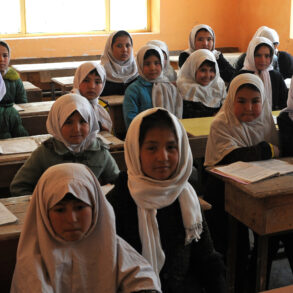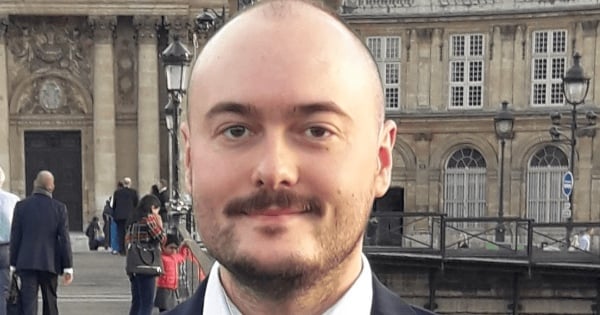
Dr. Roman Nekoliak’s biography states: “Roman Nekoliak (1992) ambitious young professional with a demonstrated history of working in the civic&social organization in Ukraine and Belgium. A Law graduate from Yaroslav Mudryi National Law University (BA, MA Kharkiv). Afterward, he continued to study law at V. M. Koretsky Institute of State and Law in Kyiv, where he achieved his Ph.D. in 2018. Furthermore, he graduated from LLM program in International and European Law, Gent University mainly focused on IHL, EU institutional law and human rights. European Solidarity Corps volunteer in Ieper, “In Flanders Fields Museum” Research Center at West Flanders (2017) . Former Council of Europe DGI trainee in Strasbourg (2020). Roman became professionally involved as a human rights defender at the Center for Civil Liberties (CCL) in 2021, where he has since been responsible for international relations, advocacy and communications. He speaks Dutch, English, Russian and Ukrainian. Interested in modern politics, history, cultural diplomacy, World War I, philosophy and the history of European unification. My hobby is the history of the First World War, literature, theatre, philosophy, jogging and badminton. Here we talk about lessons from World War I and World War 2, International Humanitarian Law, the Rome Statute, and profit and war.
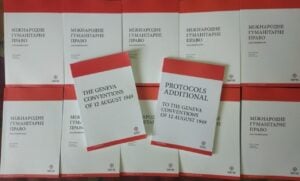
Scott Douglas Jacobsen: In studying the events of World War 1 and World War 2 in-depth, what are the major takeaways about the gradual development and then rapid onset of atrocities and excuses for mass demographic crimes?
Dr. Roman Nekoliak:When analyzing the development of the Western Front, Great War historians applied the idea of ‘the learning curve‘. This concept first appears in British academic circles and shows the BEF’s capacity for learning amplifying its 1918 victory and explaining the 1914-1917 devastating losses.
Brits were among the first to apply field gray uniforms, machine guns, barbed wire, casualty clearing stations, and tanks. While Germans were forced to counter, adapt and develop their own tactics with limited resources. The German military was the first to use far-range heavy artillery to annihilate Belgium and France’s fortifications and to terrorize Paris, and to use poison gasses. They became experts in submarine warfare and invented tactics that will be called the Blitzkrieg strategy during WW2 (Operation Faustschlag, 1918, occupation of Ukraine). Oskar von Hutier maneuvers, “Hutier Tactics” entails bypassing major enemy strongpoints while using smoke and gas shells.
One notable German artillery general on the Eastern Front during the Great War (World War I) who contributed significantly to the development of new tactics was Georg Bruchmüller. His innovative approaches to coordination, communication, and the use of artillery barrages to support infantry advances which was tested on my countrymen at the Eastern Front.
Bruchmüller developed tactics such as the “Feuerwalze” (fire wave) which involved a creeping barrage that moved ahead of advancing infantry to suppress enemy positions and allow for a more effective assault. His methods were instrumental in breaking through entrenched enemy positions and were later adopted by other armies during the war. As well as poison gasses, at the end of the war they were used by the French, British and US armies, powers that have technical capacity to produce them.
Both sides used aircraft, machine guns, tanks and armored vehicles, but the Allies had material and personnel advantage. In the present war, the use of AI, air and water drones and Starlink are the ‘learning curve’ examples.
The logic of warfare is simple: the belligerent parties will use any means possible to cause as many casualties as they can.
The lessons learned from both world wars have driven Europe towards closer integration and cooperation. However, a new conflict simmers in Europe—a conflict that tears Ukraine between two opposing directions: authoritarianism and democracy, with the looming specter of further Russian aggression in the region, potentially thwarting or undermining democratization efforts in neighboring countries.



Jacobsen: Is contemporary International Humanitarian Law struggling to deal with the modernization of the battlefield and violation of human rights into the digital sphere with digital warfare and media through dis- and mis-information campaigns?
Nekoliak: Prussian general Carl von Clausewitz, a dynamic thinker of the 19th century, grappled throughout his life with understanding and coming to terms with the profound changes in warfare witnessed during the Napoleonic Wars. He likened war to a chameleon, morphing into various shapes and forms with a proclivity for escalation. Margaret MacMillan, in her Foreign Affairs article, highlights how the 1899 Hague Convention prohibited the use of poison gas, yet Germany defied this ban and deployed it in 1915, leading the Allies to follow suit by the war’s end. In 1939, the United Kingdom refrained from bombing German military targets, citing fears of retaliation and ethical concerns. However, a year later, the UK adopted a policy of unrestricted air warfare, even at the cost of civilian lives. Consequently, during the later stages of the conflict, the Royal Air Force targeted German cities, prioritizing civilian morale as a strategic objective.
Nowadays, the following controversial question arises: Can IHL in its current state, address the instruments of modern warfare and the instruments of hybrid war alleged to Russian Federation.
Of particular concern is the deployment of cluster munitions. This trend toward escalation is evident, raising the specter of Russia resorting to the use of “tactical” nuclear weapons as the next conceivable step.
The Ukrainian frontline stretches approximately 1,500 kilometers in length. In certain segments, it features heavily fortified three-line defense systems comprising concrete bunkers and outposts, while in other areas, the role of the Dnipro River mirrors that of the IJzer in Flanders, which was flooded deliberately to stop the German advance. The conflict in Ukraine from 2014 to 2022 is described as asymmetric or hybrid, blurring the lines between wartime and peacetime, as well as between combatants and civilians. This hybrid warfare exhibits diminished adherence to international legal norms, as it diverges from contemporary laws of war. The methods of warfare have evolved rapidly, outpacing legal frameworks. Legal scholars highlight concerns such as legal ambiguities surrounding cyber and drone attacks, as well as shifts in the nature of actors engaged in extraterritorial conflicts.
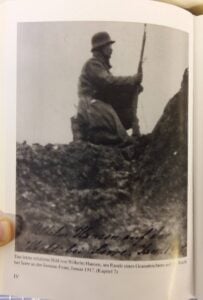


Jacobsen: Is the Rome Statute limited in its efficacy with Russia and Ukraine? For example, Ukraine is not party to the Rome Statute. The Russian Federation is not party to the Rome Statute.
Nekoliak: British international lawyer Lauterpacht coined the concept of crimes against humanity, advocating for the protection of human rights from violence. Lemkin, on the other hand, coined the term “genocide” to protect groups of people from mass extermination. Sands tells their personal stories that influenced the formation of these abstract legal principles.
These two concepts were first used at the Nuremberg trials of Nazi political and military leaders. This was a turning point in the history of international criminal law. However, more than half a century passed after this trial before the International Criminal Court (ICC) was established in 2002 on the basis of the Rome Statute.
In pursuit of justice and accountability for crimes committed by Russia, Ukraine should ratify the Rome Statute. Ratification of the Rome Statute will allow Ukraine to become a full member of the Assembly of States Parties to the ICC and to have all the procedural and organizational rights of the States Parties to the International Criminal Court. Only as a full-fledged member of the ICC will Ukraine be able to influence future processes and decisions on possible changes to the Statute.
The issue around ratification is the issue for the state to abide by international law. Ukraine advocates for parties in a conflict to comply and respect IHL rules. The CCL’s work to educate the public on IHL rules is based on the idea that a sound acquaintance with the law is essential for effective application and, consequently, for the protection of the victims of armed conflicts. CCL works toward compliance with the Geneva Conventions and their Additional Protocols by strengthening the international criminal justice system
At the moment, Ukraine has only cooperation obligations. In turn, the Court will benefit by gaining valuable experience from Ukrainian lawyers and lawyers currently working on justice issues in eastern Ukraine. In addition, it will be a significant step towards strengthening Ukraine’s international reputation. Also, ratification of the statute is one of the requirements of the EU-Ukraine Association Agreement (Article 8 of the Agreement).
The adoption of the Rome Statute is not a panacea that will solve all the pressing legal problems in the context of the Russian invasion, but it is a step in the right direction, as international cooperation against impunity for the most serious crimes is our ultimate goal. The ICC is intended to complement, not replace, the national judicial system. The work of the ICC in Ukraine and the implementation of the principle of universal jurisdiction over the most serious crimes, namely genocide, crimes against humanity, war crimes, and crimes of aggression, will strengthen Ukraine’s role as a fighter against Russian aggression for justice not only for Ukrainians but also for other countries and peoples affected by international crimes.
By ratifying the statute, Ukraine will confirm that the most serious crimes of concern to the international community should not go unpunished and that their effective prosecution should be ensured both by measures at the national level and through enhanced international cooperation.
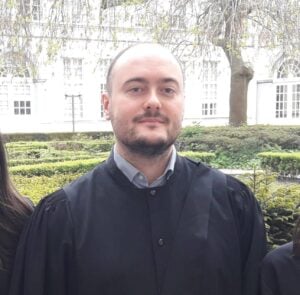


Jacobsen: What seem like the most efficacious ways to deal with the documentation of crimes and, not only demand but, deliver accountability through international law?
Nekoliak: After Russian 2014 invasion of Ukraine Ukraine’s civil society organizations have joined national resistance and defense efforts, expanding on their traditional advocacy and watchdog roles. In this regard, the Center for Civil Liberties (CCL) has had a crucial role in gathering records of war crimes after Russia’s latest invasion, building on its experience documenting war crimes and torture since the start of the War in Donbas in 2014.
The process of documenting human rights violations is a vital undertaking involving the collection, analysis, and preservation of information and evidence concerning the perpetrated abuses. This process serves a pivotal role in bringing attention to violations, holding accountable those responsible, and seeking justice for the victims.
Adherence to established standards and guidelines is fundamental in human rights documentation to ensure uniformity and credibility. For instance, the Istanbul Protocol offers guidance for documenting instances of torture, while the Minnesota Protocol provides direction for investigating unlawful killings. These frameworks standardize the documentation process and offer specific directives for documenting various human rights violations. Civil society organizations engaged in documentation efforts can benefit from familiarizing themselves with and implementing national and international standards such as the ICC Guidelines and the Berkeley Protocol. These resources furnish comprehensive guidance on human rights documentation, guaranteeing adherence to legal and ethical standards. The awareness and application of such guidelines can bolster the quality, credibility, and effectiveness of documentation endeavors in the pursuit of justice and accountability.
The documentation of war crimes and other breaches of international law necessitates strict adherence to guidelines. In 2022, the European Union Agency for Criminal Justice Cooperation (Eurojust) and the Office of the Prosecutor of the International Criminal Court (ICC) issued practical guidelines for Civil Society Organizations (CSOs) in response to requests for clearer direction on effective documentation methodologies. These guidelines prioritize the protection of individuals, particularly vulnerable individuals, and underscore the importance of preventing multiple interviews with the same person. This approach aims to safeguard the well-being of individuals providing testimony and to uphold their willingness to participate in the accountability process. Consequently, the ICC’s guidelines focus on approaches to vulnerable individuals, the handling of testimonies, photographs, videos, documents, digital information, physical items, as well as the storage, safeguarding, and analysis of collected information.
Our documentation work as well as the efforts of other NGOs and journalists have helped to highlight issues that need to be addressed immediately to prevent further mass human rights violations and spark response from international community. Such as the forced relocation of hundreds of thousands of Ukrainian citizens including children to the territory of the Russian Federation.



Jacobsen: With the new dimensions in modern warfare, what updates may be necessary for International Humanitarian Law in adapting to modern conflicts?
Nekoliak: Thus, one of the preludes to the war of aggression has been the continued increase in Russian hacking with high-level attacks on certain infrastructure – power stations, telecommunications centers, businesses. At the same time, the Russian Federation has significantly increased the amount of disinformation disseminated – not only in the media, but also on social networks through controlled bloggers and trolls – thus preparing the ground for the invasion.
In 2022, Ukraine (officialy, confirmed cases) suffered more than 4500 cyber attacks from Russia. During these attacks, Moscow is primarily targeting civilian or government infrastructure: the energy and logistics sectors, government databases or military facilities. Targeted attacks are carried out against companies in order to take control of them and disrupt the functioning of services. Ransomware is also deployed in an attempt to encrypt computers. To carry out these attacks, the Russian government can count on groups of hackers close to the GRU, the Russian military intelligence.
Ukraine obviously wants to prevent unbacked up databases from being manipulated, or critical infrastructure from being hit and data lost. At the beginning of the conflict, for example, a government data center was damaged by Russian missiles. Ukrainian citizens could also be put at risk if some data fell into Russian hands, allowing for example the tracking of population movements. These reasons again motivate the Ukrainian government to get the data out of the country.
Cyberattacks on Ukraine since late March include phishing emails targeting the government and armed forces and various organisations, as well as the use of a LoadEdge backdoor to install surveillance software. Cyberattacks on Ukrtelecom and WordPress websites caused communication disruptions and restricted access to financial and government websites. On 30 March, the MarsStealer ransomware gained access to the credentials of Ukrainian citizens and organisations.
The main goal of hackers is cyber espionage, disruption of the availability of public information services and destruction of information systems. Experts from the State Cyber Defence Centre have recorded a significant increase in the spread of malware that enables hackers to steal data or even destroy it. Microsoft has launched a report Defending Ukraine: Early Lessons from the Cyber War, it highlights that Russia tends to start its attacks both in digital space and through massive shelling simultaneously. The clear example of it is the launch of missiles against the governmental buildings of Dnipro, while launching the massive cyberattack. The Microsoft concludes with the following statement: “we will proactively work to prevent our platforms and products from being used to amplify foreign cyber influence sites and content. … we will not wilfully profit from foreign cyber influence content or actors.” These shows that establishing the security within the digital space and enforcing the digital rights of the population could be done in the collaboration with the main private companies such as Microsoft. It is in both, states, and private business, benefit to counter the threat which circulates in the digital space.
Communication is essential in wartime, so network infrastructure has been targeted early on by Russia. Connectivity disruptions are mainly caused by physical damage to optical cables or relay antennas. Through these attacks, the Russian Federation is trying to fragment the Ukrainian digital space, for example by switching people living in occupied areas to Russian networks (by distributing Russian SIM cards). The aim is twofold: to cut off the access of these populations to factual information about the war and to open a new channel for Russian propaganda. Two days after the beginning of the invasion, Mykhailo Fedorov, Minister of Digital Transformation made a request to Starlink terminals to fight against these attacks. This is a satellite internet connection service launched by Space X, a company of Elon Musk. Ten hours later, Elon Musk confirmed the activation of its network in Ukraine. Ukraine’s efforts in these areas via digitization makes the occupation of the territories by the Russian army significantly more difficult. In the territories from which Ukraine has temporarily withdrawn and where the occupation administration has launched Russian rubles and erected its symbolic markers – such as flags and monuments – the Ukrainian state is represented digitally and remains in contact with its citizens.
On March 29, 2022 for example, Ukrainian forces arrived in Irpin and found that the population was unable to contact their relatives after the destruction of 24 relay antennas in the city. On March 31, a terminal is brought to the site, an antenna mounted on a mobile motorized base and the whole is powered by a generator. As a result, the city is once again connected and the inhabitants rushed to their phones to inform their relatives that they were safe and sound.
This scenario has been repeated all over the country. In spite of the important damages on the infrastructures, many Ukrainians still have access to Internet thanks to Starlink which would count not less than 150 000 daily users in the country. The satellite network could be operated in Ukraine thanks to the government’s authorization to use certain ranges of waves (contrary to France which prohibited it).
Since February 24, 2022 Telegram is the main communication tool for Ukrainians. It is used to disseminate information and first-hand video and photo documentation about the war. It also serves as the main tool for coordination in emergency situations. A Ukrainian citizen with a smartphone and access to the Internet can become a digital activist. The content about the war that Ukrainians are creating en masse has made it impossible to hide the truth about what is happening and has reduced the effectiveness of Russian propaganda.
There is also an organizational innovation: the digital crowdsourcing of collective action. People come together on Internet platforms to form volunteer groups: from digital troops launching cyberattacks on Russian state websites to communities buying and distributing humanitarian aid. Most of the time, these are local initiatives with a startup logic: there’s a problem, let’s solve it. The group that comes up with the first viable solution “wins”.
The situation in Ukraine shows that the division between “civilian” and “military” use of technology is becoming obsolete. In peacetime, Starlink delivers Internet to farmers and drones deliver ordinary packages. In wartime, satellite Internet is used by artillery, while drones assist with intelligence and launch missiles at enemy positions. Gone are the days when the military-industrial complex was a closed sphere: it is now easy to transform peaceful civilian technologies into military ones and vice versa. Although any technology is value-neutral, it can be used both to unify society and implement the rights and freedoms of citizens in a democracy, but also to control and establish authoritarian dictatorships. The “cure” for technological dictatorship is the conscious implementation of the values of democratic freedoms in the digitalization project.
Before the start of the large-scale war, Ukraine was already actively digitizing, guided by the concept of “the state in a smartphone”. Thanks to the Diia application, citizens had access to a passport, driver’s license, vaccination certificate, digital signature, the ability to petition, obtain certificates and register legal status for private business activities. During the war, the chatbot êVorog was created, based on Diia. It allows citizens to securely transmit information about the enemy to the state authorities, even while in the occupied territories. Another example of what the application enables is that the need for digital identity solutions has become acute due to the conflict. IDPs may no longer have access to their paper documents, and those who have taken refuge abroad urgently need to have their Ukrainian identity recognized in their host country. They can obtain a simplified digital ID through Diia, which is recognized by local authorities and border guards in neighboring countries. Similarly, workers living in conflict zones can check their entitlements to financial aid and apply for it directly through the Diia app. The service delivery system has also evolved over time, from almost no services in the days following the invasion, to the provision of all but 28 of 2230 important services three months later, once the system had been adapted to the new risks.
The war has prompted the Ukrainian government to apply for membership in the European Union and, in turn, for access to the EU’s digital single market, which requires alignment with international regulations and standards. On February 28, 2022, the European Council received Ukraine’s application for EU membership. On June 17, the European Commission issued its opinion recommending that the Council accept the country’s application. In this opinion, specific mention is made of Ukraine’s “particularly good performance” in the field of information society and media (within the thematic group “Competitiveness and inclusive growth”).
The war has shown us that a digital state is not only a state that provides digital services to citizens. In the most difficult times, it is the digital infrastructure that plays a key role in security, solidarity and the implementation of democracy. Ukraine’s experience can help create a coherent vision of digitalization by linking it to the idea of European digital sovereignty.
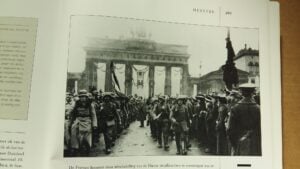


Jacobsen: With the third year of the conflict upon us, what are the prospects for peace?
Nekoliak: Recent developments raise questions about whether the momentum towards establishing an international rule of law has diminished. Interstate crises in various regions suggest a renewed focus on geopolitical spheres of influence. Efforts to address global challenges through universal international law face hurdles. In this context, are we still witnessing the advancement of international relations governed by universally accepted values, or are we seeing a trend towards informalization, reformalization, or even the erosion of international legal norms? Alternatively, could the slowdown in progress towards an international rule of law rooted in shared values simply be a temporary phase? Furthermore, is the current landscape witnessing the resurgence of realpolitik, signaling the emergence of a different type of international law?
This scenario aligns with the French proverb “a la guerre comme à la guerre,” which advocates for a pragmatic stance toward warfare. It suggests making the most of available resources to accomplish necessary tasks without dwelling on the associated costs. Russia’s utilization of diverse conventional armaments without achieving their objectives implies a potential shift towards non-conventional means, such as chemical or nuclear weapons, prohibited by international law.
As the conflict in Ukraine enters its third year, two-thirds of the world’s population resides under autocratic regimes. The prospect of Russia emerging triumphant in Ukraine raises concerns about a bleak future where force dictates governance and borders are redrawn through violence, potentially setting the stage for a more devastating confrontation in Europe.
Furthermore, such an outcome would reinforce the perception of a significant decline in Western influence and the universal principles it espouses. The European Union’s success, coupled with Ukraine’s aspirations for EU and NATO membership and the United States’ support for Ukrainian democracy, poses a threat to Russian ambitions to establish dominance in the region. Snyder argues that Russian political elites are engaged in a propaganda campaign to discredit the EU as a morally decadent institution, fearing that its success may inspire dissent within Russia itself, thus jeopardizing its existence.
Putin’s aim to dismantle democracy in Ukraine and strip its citizens of their political identity and civil liberties has resulted in the loss of countless Ukrainian lives, widespread destruction of critical infrastructure, mass displacement of millions, increased incidents of torture and sexual violence, and heightened repression within Russia.
The future of Europe hinges on its Eastern borders, where a struggle between incompatible systems—democracy versus authoritarianism, individualism versus totalitarianism—unfolds. If the First World War shattered empires and the Second World War epitomized extreme nationalism, the success of the EU lies in integrating former imperial fragments into the world’s largest economy and most significant bastion of democracy. EU will fail without Ukraine.
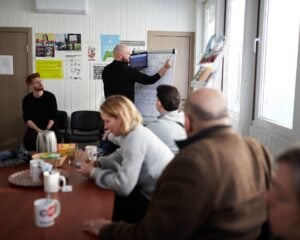


Jacobsen: What are the relevant human rights organizations reporting on Ukraine now?
Nekoliak: Various initiatives are underway to document Russian war crimes in Ukraine, aiming for accountability, justice, adherence to the rule of law, establishment of truth, preservation of historical memory, and future transitional justice. The collection and preservation of information about these crimes can empower national and international courts and authorities to pursue prosecutions, providing a solid foundation of testimonies and evidence even before international investigators arrive on the scene.
Firstly, Ukrainian state investigative bodies such as the Security Service of Ukraine, the General Prosecutor’s Office, and the National Police are actively engaged in documenting, investigating, and prosecuting these crimes. Secondly, the international criminal justice system, including organizations like the ICC, UN, OSCE, and the Council of Europe, plays a role, albeit to a lesser extent. Thirdly, Ukrainian and international civil society organizations are actively complementing, assisting, and sometimes leading documentation efforts.
Two Ukrainian civil society communities, T4P led by jointly by the Center for Civil Liberties, UHHRU, KHRG and Coalition 5 AM led by ZMINA, are specifically focused on documenting Russian war crimes in Ukraine. Additionally, numerous international organizations are pursuing accountability for core international crimes committed in Ukraine, including Amnesty International, Bellingcat, the Global Legal Action Network (GLAN), Global Rights Compliance, the Coalition for the International Criminal Court (CICC), the European Center for Constitutional and Human Rights (ECCHR), Mnemonic – Ukrainian Archive, the Open Society Justice Initiative (OSJI), Redress, Clooney Foundation for Justic and TRIAL International.
The collective efforts of these organizations have resulted in the publication of several reports, including the OSCE Report on Violations of International Humanitarian and Human Rights Law, War Crimes, and Crimes Against Humanity; the GAN UTF White Paper covering war crimes and crimes against humanity committed by the Russian Federation; the UN Human Rights Monitoring Mission in Ukraine (HRMMU) report; reports from Human Rights Watch and Amnesty International, among others.
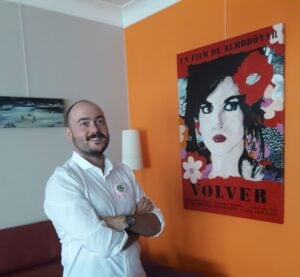


Jacobsen: Roman, thank you for your time again.
Nekoliak: Thank you.
Further Internal Resources (Chronological, yyyy/mm/dd):
Humanist
Humanists International, Russian Federation, Ukraine, and the United Nations (2024/01/08)
Personal
The Long Happenstance of Iceland and Copenhagen (2023/12/09)
Romanian
Remus Cernea on Independent War Correspondence in Ukraine (2023/08/25)
Zaporizhzhia Field Interview With Remus Cernea (2024/02/21)
War and Destruction With Remus Cernea (2024/02/22)
Ukrainian
Ms. Oleksandra Romantsova on Ukraine and Putin (2023/09/01)
Oleksandra Romantsova on Prigozhin and Amnesty International (2023/12/03)
Dr. Roman Nekoliak on International Human Rights and Ukraine (2023/12/23)
Sorina Kiev: Being a Restauranteur During Russo-Ukrainian War (2024/01/27)
***


If you believe in the work we are doing here at The Good Men Project and want a deeper connection with our community, please join us as a Premium Member today.
Premium Members get to view The Good Men Project with NO ADS. Need more info? A complete list of benefits is here.
—
Photo credit: Roman Nekoliak.
This post was originally published on this site be sure to check out more of their content.






